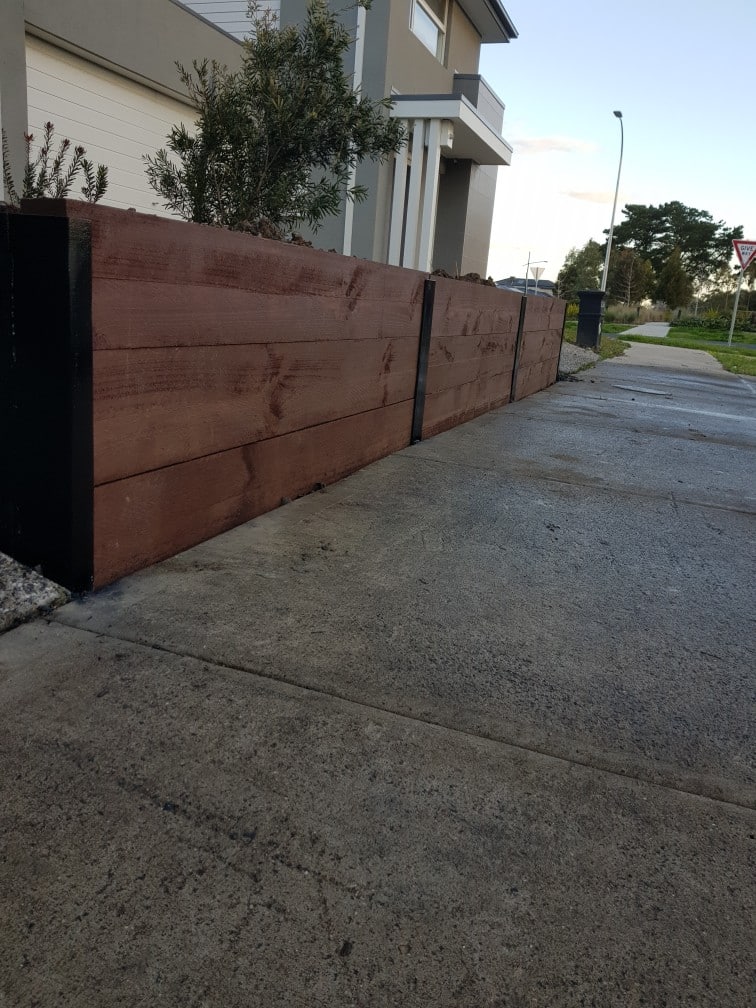Many Melbourne homes feature retaining walls as part of their landscaping — but not all are designed with families in mind. If you have young children, your retaining walls need to combine safety, functionality, and visual appeal.
Here’s what to consider when choosing the best retaining walls for Melbourne homes with kids.
Key Safety Considerations
Height
Height is one of the most important safety factors for families. Where possible, choose retaining walls under 1 metre to minimise fall risk. If your property requires a taller wall:
- Use tiered designs with wide, level terraces
- Landscape with grass, soft mulch, or groundcover between levels to cushion falls
- Avoid sheer drops that can cause serious injury
Rounded or Smooth Edges
Standard retaining walls often have sharp corners that can cause cuts or bruises during play. To reduce hazards:
- Select rounded capping stones or bullnose edges
- Avoid jagged rock finishes, exposed steel, or protruding bolts
- Have stone surfaces honed or smoothed by professionals

Safe Materials and Surfaces
Material choice affects both safety and comfort:
- Concrete sleepers or honed natural stone provide smooth, durable finishes
- Avoid splinter-prone timber unless it’s treated, sealed, and maintained regularly
- Choose materials that stay cooler under the sun – especially for play areas
- Use textured, non-slip sealants to reduce slipping after rain
Fencing or Barriers
Under Victorian building regulations, retaining walls over 1 metre in height may require a fence or barrier, especially if close to driveways, footpaths, or play zones. For added safety:
- Install non-climbable fencing with vertical slats or solid panels
- Use dense planting in front of taller walls as a natural deterrent
Best Materials for Family-Friendly Designs
Pros
Cons
Timber
- Natural appearance for kid-friendly space
- Easy and affordable installation
- Blends in with backyard play area
- Can splinter without regular maintenance
- Requires regular sealing to be safe
- Susceptible to warping, rot, and termites
Concrete Sleepers
- Comes in smooth, child-safe finishes
- Low maintenance and termite-resistant
- Durable and long-lasting
- Costs more to install than timber sleepers
- Can heat up in direct sun - best in shaded areas
Gabion
- Can be filled with smooth stones to eliminate sharp edges
- Modern appearance
- Sturdy and suitable for erosion control
- Metal mesh cages can rust without proper coating
- Poses climbing risks for young children
- Gaps in mesh can trap items or fingers
Rock
- Long lifespan when installed by a professional
- Allow curved and organic shapes
- Blends well with landscapes
- Uneven corners can be hazardous for young children
- Prone to shifting over time
- Difficult and expensive to repair
Pros
Timber
- Natural appearance for kid-friendly space
- Easy and affordable installation
- Blends in with backyard play area
Concrete Sleepers
- Comes in smooth, child-safe finishes
- Low maintenance and termite-resistant
- Durable and long-lasting
Gabion
- Can be filled with smooth stones to eliminate sharp edges
- Modern appearance
- Sturdy and suitable for erosion control
Rock
- Long lifespan when installed by a professional
- Allow curved and organic shapes
- Blends well with landscapes
Cons
Timber
- Can splinter without regular maintenance
- Requires regular sealing to be safe
- Susceptible to warping, rot, and termites
Concrete Sleepers
- Costs more to install than timber sleepers
- Can heat up in direct sun - best in shaded areas
Gabion
- Metal mesh cages can rust without proper coating
- Poses climbing risks for young children
- Gaps in mesh can trap items or fingers
Rock
- Uneven corners can be hazardous for young children
- Prone to shifting over time
- Difficult and expensive to repair
If you want limited upkeep, peace of mind, and functionality, concrete sleepers are a stable and low-maintenance retaining wall option. They offer impressive structural integrity and are resistant to moisture. If you’re building lower retaining walls, another option is to use treated and sealed timber.
Design Ideas That Work for Kids
Built-in seating, Level Play Areas, and Gentle Steps
Incorporating benches into retaining walls is a great way to add shaded resting spots near play zones. It’s also useful around cubby houses, garden beds, and sandpits. If your yard has uneven spots, retaining walls are an effective way to convert them into usable spaces for ball games, swings, and trampolines. Consider adding wide and shallow steps into the wall design, along with handrails for easy accessibility.
Avoiding Slippery Zones and Climbable Structures
Avoid building freestanding walls without fencing or visual barriers in front, as it can tempt kids to climb. Similarly, adding planters along terraces can discourage children from climbing tiered walls, while improving the landscape. To avoid slippery zones after rain, make sure steps and ledges have enough texture to provide traction
Professional Support Matters
It may be tempting to tackle a retaining wall project on your own, but professional support is crucial to ensure your family’s safety. One of the biggest reasons to hire specialists is that they can tell you when permits are needed. In Melbourne, this is usually when the retaining wall is over a metre tall or if it’s built near a boundary, shared fence, or footpath. Licensed professionals have the experience to navigate the process of securing a permit and finishing the job quickly. They also know how to design walls depending on the local soil and weather conditions, such as tightly packed soil with poor drainage or areas with high rainfall. With Jamesco Group, you can get integrated fencing and retaining wall solutions that keep your family safe.
Create a Safe Backyard With Quality Retaining Walls
For families that live with young children, retaining walls in Melbourne should be child-friendly, functional, and visually appealing. At Jamesco Group, our experts can help you select materials and designs to suit your needs. Get in touch with us for a detailed quote.
